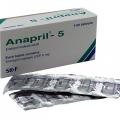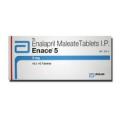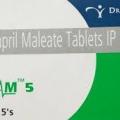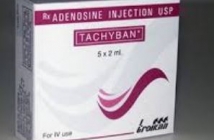Home / Categories / ACEPRIL-5MG

ACEPRIL-5MG
(10)
ENALAPRIL-5MG
ACE INHIBITORS
S.R. DRUG LAB, NEPAL
Product Details
Enalapril Maleate
A to Z Drug Facts
| Enalapril Maleate |
| (EH-NAL-uh-prill MAL-ee-ate) |
| Vasotec |
| Class: Antihypertensive/ACE inhibitor |
 Action Competitively inhibits angiotensin I-converting enzyme, preventing conversion of angiotensin I to angiotensin II, a potent vasoconstrictor. Clinical consequences include decreased sodium and fluid retention, decreased BP, and increased diuresis.
Action Competitively inhibits angiotensin I-converting enzyme, preventing conversion of angiotensin I to angiotensin II, a potent vasoconstrictor. Clinical consequences include decreased sodium and fluid retention, decreased BP, and increased diuresis.
 Indications Treatment of hypertension and symptomatic CHF in combination with diuretics and digitalis and asymptomatic left ventricular dysfunction after MI. Unlabeled use(s): Treatment of diabetic nephropathy, childhood hypertension, and hypertension related to scleroderma renal crisis.
Indications Treatment of hypertension and symptomatic CHF in combination with diuretics and digitalis and asymptomatic left ventricular dysfunction after MI. Unlabeled use(s): Treatment of diabetic nephropathy, childhood hypertension, and hypertension related to scleroderma renal crisis.
 Contraindications Standard considerations.
Contraindications Standard considerations.
Hypertension
ADULTS: PO Initial dose: 2.5 to 5 mg/day. Titrate to desired BP control. Usual maintenance dose: 10 to 40 mg/day in single or twice daily doses.
Renal Function Impairment
ADULTS: PO Titrate dosage upward until blood pressure is controlled or until a max dosage of 40 mg/day is reached. Use an initial dosage of 5 mg/day in normal renal function and mild impairment (Ccr > 30 ml/min); 2.5 mg/day in moderate-to-severe renal impairment (Ccr > 30 ml/min); and 2.5 mg on the day of dialysis in dialysis patients (adjust dosage on nondialysis days based on blood pressure response).
Heart Failure
ADULTS: PO Initial dose: 2.5 mg bid. Usual dose: 2.5 to 20 mg/day in 2 divided doses (max 40 mg/day). Titrate doses upward as tolerated over a period of a few days or wks. The max daily dose is 40 mg in divided doses.
High-Risk Patients
ADULTS: PO Hypertensive patients at risk (eg, those with heart failure, hyponatremia, high-dose diuretic therapy, recent intensive diureses or increase in diuretic dose, renal dialysis, or severe volume or salt depletion of any etiology) have potential for extremely hypotensive response. Initiate therapy under very close medical supervision. The starting dose should be £ 0.625 mg administered IV over a period of ³ 5 minuts and perferably longer (up to 1 hour).
Left Ventricular Dysfunction
ADULTS: PO Initial dose: 2.5 mg bid. Titrate to targeted daily dose of 20 mg in divided doses.
Allopurinol: Greater risk of hypersensitivity possible with coadministration. Antacids: Enalapril bioavailability may be decreased. Separate administration times by 1 to 2 hrs. Capsaicin: Cough may be exacerbated. Digoxin: Increased digoxin levels. Indomethacin: Hypotensive effects may be reduced, especially in low-renin or volume-dependent hypertensive patients. Lithium: Increased lithium levels and symptoms of lithium toxicity may occur. Phenothiazine: May increase pharmacological effect of phenothiazines. Potassium preparations, potassium-sparing diuretics: May increase serum potassium levels. Rifampin: Pharmacologic effects of enalapril may be decreased.
 Lab Test Interferences False elevation of liver enzymes, serum bilirubin, uric acid, or blood glucose may occur.
Lab Test Interferences False elevation of liver enzymes, serum bilirubin, uric acid, or blood glucose may occur.
CV: Chest pain; myocardial infarction; hypotension; angina; orthostatic hypotension; tachycardia; syncope; vasculitis. CNS: Headache; vertigo; dizziness; fatigue; asthenia. DERM: Rash; photosensitivity. GI: Nausea; abdominal pain; vomiting; diarrhea. Urinary tract infection. HEMA: Decreased hemoglobin and hematocrit; neutropenia; agranulocytosis; thrombocytopenia; pancytopenia; eosinophilia. META: Hyperkalemia. RESP: Bronchitis; continuing cough; dyspnea. OTHER: Fever; myalgia; arthralgia; arthritis.
Pregnancy: Category D (second, third trimester); Category C (first trimester). Lactation: Excreted in breast milk. Children: Safety and efficacy not established. Angioedema: May occur. Use drug with extreme caution in patients with hereditary angioedema. Cough: Chronic dry cough may occur during treatment; higher incidence in women. Hypotension/first-dose effect: Significant decreases in blood pressure may occur after first dose, especially in severely salt- or volume-depleted patients or in those with heart failure; monitor closely for ³ 2 hr after initial dose and during first 2 wk of therapy. Minimize risk by discontinuing diuretics, decreasing dose, or increasing salt intake » 1 wk prior to initiating enalapril. Neutropenia and agranulocytosis: Have occurred; risk appears greater with renal dysfunction, heart failure or immunosuppression; monitor WBC counts frequently. Renal impairment: Reduce dose and give less frequently. In renal insufficiency, stable elevations in BUN and serum creatinine may occur because of inadequate renal perfusion; monitor renal function during first few wks of therapy and adjust dosage.
| PATIENT CARE CONSIDERATIONS |
|
- May be administered without regard to meals.
- Obtain patient history, including drug history and any known allergies.
- Obtain baseline weight.
- Monitor patient's BP and pulse before therapy and regularly during treatment.
- Monitor I&O.
- If precipitous drop in BP develops, notify physician and administer with IV fluids or plasma volume expanders as prescribed.
- If signs of fluid overload develop (increase in weight, dyspnea, rales/crackles, jugular vein distention), notify physician immediately.
- If vertigo, dizziness, or fatigue develops, notify physician.
|
||||
- Teach patient and family name, desired action, method of administration, and potential side effects of enalapril.
- Explain protocol for missed doses, and caution against taking missed dose with the next dose.
- Teach additional interventions for control of hypertension (weight reduction, exercise, stress management, stopping smoking).
- Inform patient of potential for temporarily altered impairment of taste sensation and for chronic cough.
- Instruct patient to make position changes slowly and to wait a few mins before standing to minimize orthostatic hypertension.
- Teach patient and family how to measure BP and pulse.
- Emphasize importance of regular follow-up visits, and explain that hypertension is controlled, not cured.
- Instruct patient to report these symptoms to physician: Rash, fever, chest pain, hives, or dyspnea.
Books@Ovid
Copyright © 2003 Facts and Comparisons
David S. Tatro
A to Z Drug Facts
Substitutes

 Route/Dosage
Route/Dosage Interactions
Interactions Adverse Reactions
Adverse Reactions Precautions
Precautions Administration/Storage
Administration/Storage Assessment/Interventions
Assessment/Interventions Patient/Family Education
Patient/Family Education



